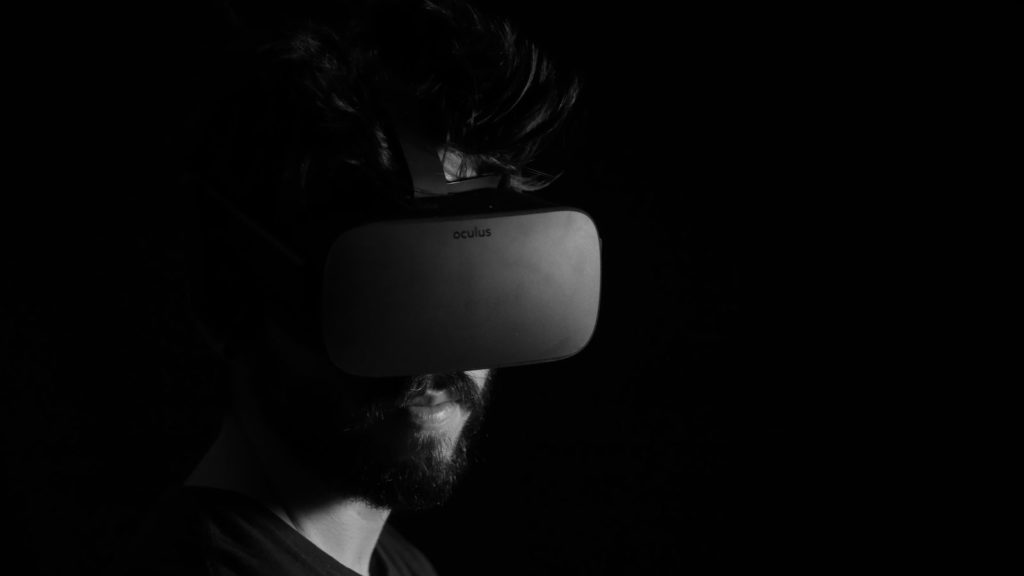VR APPS ONLINE!

What is actually meant by “immersive content” or “immersion VR”? Did the term ‘immersion’ originate with the onset of new technology such as augmented reality, virtual reality or mixed reality?
We’ll give you the answers you’re looking for!
In this article we will tell you everything you need to know about the term “immersion”!
Table of Contents
Immersion (the technical term for immersing oneself in an artificial world) describes the effect caused by a situation, environment or graphic representation which makes the user’s consciousness recede into the background so that the virtual environment is perceived as reality.
Nikolayi Engelmann
This is how Nikolayi Engelmann describes it in his book “Virtual Reality Gaming”.
The term ‘immersion’ comes from the Latin immersio, which means to immerse.
Immersion can be divided into two types. On the one hand, there is mental and physical immersion. Both of these target the same thing. However, we can broadly say that physical immersion enhances mental immersion.
This kind of immersion occurs when the user submerges themselves in a certain storyline. In other words, they dive right into it.
We all know what it is like and have probably experienced mental immersion a number of times. For example, when we are reading an exciting book and imagine the action in our heads using vivid images. Sometimes we are also disappointed, can’t believe it or are even sad when a certain plot in a film doesn’t turn out as we imagined it would.
It is in these moments that we feel a deep commitment to various plots and are willing to accept fiction or fantasy.
Physical immersions are more of a proverbial “on top” to mental immersion. All the physical things that our diverse senses perceive increase and strengthen mental immersion.
What exactly does that mean?
As an example, let’s take a fictional VR game where you have super powers and can fly. We put on our glasses and start our adventure as Superman.
It is in this moment that the first physical immersion happens solely through VR. We are shielded from the outside world. No matter how we turn our head, we will always be looking into the virtual environment.
Then we take off. What could increase our physical immersion when flying?
A cold stream of wind blowing against us!
Let’s imagine that fans suddenly start blowing in our gaming room as soon as we begin to fly in VR. This way, our body will actually feel the wind and cold. The whole experience suddenly becomes much more immersive than before.
At this point, we could give many examples of how we could influence our senses to intensify physical immersion. I am thinking here of special gloves with haptic feedback, smells and tracking treadmills. What else do you have in mind?
You hear the garden door open. You run for cover as soon as you can. Leaning against the wall, your breathing gets faster and faster, with adrenaline pumping through your veins.
With your gun drawn, you take a quick look around the corner. Your housemates have no idea you’re waiting for them. You slowly put on the weapon and press it against your shoulder. You press your head against the cold, mental end of the weapon to target one of your housemates through the aimer.
You wait for the right moment. Your breathing slows down and your knees begin to shake. You pull the trigger with purposeful intent. Your target falls to the ground.
This is not the story of an exciting thriller, but just a normal afternoon in the life of a little boy playing in the garden with his parents.

Regardless of the role played back then, whatever castles you built or how many toy cars crashed into each other: The fictional ideas that permeate children’s games were probably the most immersive experiences we all enjoyed.
Although the term ‘immersion’ is a constant companion to Virtual Reality, it is by no means the result of new technologies. It has been used in various fields since the 17th century.
It’s a term we all know the meaning of. In short, it means ‘being there’.
In the context of immersion, however, a somewhat different kind of presence is meant. It’s a derivative of the word “telepresence”.
Telepresence describes the state of feeling present in a distant or virtual environment. For this reason, it can be seen as an essential feature of Virtual Reality.
In a nutshell, the higher the immersion, the more real or present the user feels in the distant environment.
Again, presence or telepresence are not terms derived from the environment of Virtual Reality technology. It has existed for a long time, just like the term ‘immersion’.
You can feel a certain amount of telepresence even when you’re on the phone. This is because two people that are located in completely different places are – at least acoustically – in one and the same room through a communication medium.
For this reason, immersion is also a basic prerequisite for presence when it comes to VR.

The feeling of immersion can be achieved especially well through Virtual Reality. And it’s much easier than with a normal TV series or a film. I have already mentioned that immersion can be enhanced very well within VR through shielding.
Our bodies and brains are more prone to trust what we see. We all too often let ourselves be deceived in our everyday lives by what we see. Our brain can quickly adapt to Virtual Reality and accepts the “unreal” world.
Due to the acceptance and the presence that results from it, you can quickly experience unattractive side effects such as “motion sickness”.
While our brain thinks it is running in Virtual Reality, the body sends signals that it is actually standing or sitting still, because in reality you are only wearing VR glasses. It is precisely these contradictory signals that can quickly make you sick. A clear case of “motion sickness”
There are certain techniques that make it possible to increase the immersion of users. Two good examples here would be:
Spatial sound has long since found its way into the gaming industry. Using spatial sound, the sound in the game follows the visual effects.
You can also use spatial sound very effectively within Virtual Reality. It is not only suitable for games, but also for storytelling to help direct the user’s gaze.
You can vividly imagine a user constantly rotating their head in a 360° city tour. So that they can really see everything.
The gaze of the users can be controlled with a simple tour guide that is placed correctly. The sound of their voice actually comes from the direction they are speaking or where they are standing at that moment.
Involve your users in the content of a VR experience. It is possible to greatly increase immersion by getting the user to interact with the content.
The user could decide the order of the scenes by choosing a certain path themselves. It is precisely this aspect that our customers rely on. Users can interact with various hotspots or move from scene to scene. This way, they are able to move freely in VR.
Ah, the holy grail of Virtual Reality technology. Total immersion in the content. Boundless devotion. The virtual world is becoming a reality.
A conceivable scenario, but not feasible with today’s technology. This requires a whole lot of fictional technology.
A fully immersive virtual world would be able to reproduce each of our senses, thoughts and so much more in a completely artificial environment. Absolutely no detail may be omitted here. Any disturbance, or even the slightest contradictory signal (we’ve already spoken about this) to our body would pull us out of the fully immersive world. And suddenly we’d realize that it wasn’t all real.
It simply requires too much additional technology, which does not even exist today. Where would you even start? How do we address our senses of touch or smell in a technical manner?
From a historical point of view, VR technology is still in its infancy. It was only this year that Oculus managed to achieve acceptable room scaling without cables or separate tracking cameras with the Quest. That would have been unthinkable three years ago.
Since there are no fully immersive Virtual Reality experiences at this current stage of development, we can now ask ourselves the following question:
What about non-immersive experiences? Does Virtual Reality always have to be completely immersive to be successful?
No!
As we have already learned, Virtual Reality always bring a certain degree of immersion with it. However, complete immersion is not necessary to create a good VR experience.
You don’t have to be taken off into another world to enjoy a 360° view of an apartment. Nevertheless, such an experience gives me exactly the information I need.

There is no guarantee of immersion within VR. After all, what causes one user to feel completely immersed can leave another user cold. There is a gap in the acceptance of artificial content.
This gap is known as the “uncanny valley”. The “valley” describes a strong slump in a curve diagram, which represents the acceptance of artificial content.
This acceptance differs from person to person, especially in the area of Virtual Reality.
Previous experience and a sense of entitlement are the archenemies of immersion. Virtual content is viewed much more critically by experienced users than by users wearing VR glasses for the first time.
As a general rule, newcomers are usually over the moon. On the other hand, experienced users often ask technical questions such as “What is the device’s pixel density?” Is that even 60 FPS right now? etc.
Have you already had some experiences in Virtual Reality? What exactly did you try and how did you feel about it?
Please share any comments you have about this topic – we would love to hear from you!
Register for free and start editing!